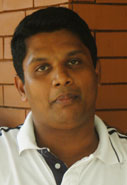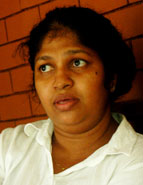News
Conflicting statements made as case comes up before Colombo Fort Magistrate tomorrow
View(s):By Kumudini Hettiarachchi
As the parents of a five-year-old girl made many serious allegations against the Nawaloka Hospital over her death and the hospital authorities responded with a media statement on Friday, the issue comes up in the Colombo Fort Magistrate’s Court tomorrow (Monday). When the Sunday Times visited the bereaved family in their home at Mabima in the Kelaniya area last Tuesday, the alms-giving in memory of Buddhini Kaushalya Ratnayake was just over.

No more: Buddhini Kaushalya
This is the second alms-giving, said father Thilanka Ratnayake, explaining that as they had suspicions that their child had died earlier, although the hospital was allegedly keeping her in the Surgical Intensive Care Unit (SICU), his wife, Chamila Kumari Ekanayake, had already given the first alms-giving to the temple near their home.
The child, whom the parents say was suffering from Rett Syndrome (see box), had been admitted to Colombo’s Nawaloka Hospital on January 31 as her doctor had ordered several tests including a Magnetic Resonance Imaging (MRI) scan.
There were no major issues with Buddhini, is mother Chamila’s contention, while both parents are adamant that the child was not prone to fits (seizures). According to Chamila her daughter had development delays earlier but the child was alright and even attending a Montessori for normal children. On January 30, she had seen something like a shiver passing through the child several times and wanted it checked by the doctor. That was when the doctor ordered three blood reports, an EEG and an MRI scan.
While the other tests were done on January 31, accompanied by an attendant Chamila carried her daughter to the MRI room at about 4 p.m. on February 1. Buddhini akkala denna ekka hondatama dangalala hitiye, she says, explaining that her daughter had been playing a lot with her two elder sisters. She had been fed at 10 a.m. and given some medication half-an-hour later and was kept fasting thereafter and was grumbling because she was hungry.
In the MRI room, when her daughter closed her eyes on being given some medication through the cannula, she (Chamila) was asked to leave and she stood by the door, which was open. It was around 4.20 p.m. and only one doctor was in the MRI room. In about 10 minutes, there was a loud sound, “like a balloon bursting, and she alleges that she heard the doctor shouting babage bag eka pipuruwa (the baby’s bag has burst)
No one came to her aid, the mother claims and she pushed the attendant who was with her into the room to help the doctor. When the doctor shouted about oxygen, she looked in and saw her daughter stiff and blue, with her stomach swollen.
It was only about 7-8 minutes later that other doctors rushed into the room. Several oxygen cylinders and equipment were brought before the one suitable for her daughter was found about 20 minutes later, according to Chamila.
People were thumping Buddhini’s chest in attempts to revive her and finally told her that they had revived her before they took her daughter to the SICU. Here they covered her with a black blanket with only the chest area and head open, says Chamila while Thilanka charges that on February 4 he saw ants creeping into her nose and the little one’s nails were blue.
The hospital authorities had complained to the Slave Island Police that the parents were creating a problem. The parents in return said they had to make a statement to the police, adding that it was on February 6, after their statement was given, that the hospital authorities requested them to sign papers to permit the hospital staff to switch off the machines Buddhini was on.
Meanwhile, stating that the hospital was “reluctantly compelled” to issue a media release, Nawaloka when contacted by the Sunday Times reiterated that the death of Buddhini was “in no way due to the fault/negligence of the hospital”.
 |
 |
| The bereaved parents in their home at Mabima. Pix by Nilan Maligaspe | |
Giving a “brief summary of the facts”, the hospital stated that the child suffered from Rett Syndrome as revealed by her mother and published in the media. Rett Syndrome is a rare genetic disorder which affects the way in which the brain develops. Over time, children with Rett syndrome have increasing problems with movement, coordination and communication that may affect their ability to use their hands, communicate and walk. As the disease progresses, fits are well known to occur.
The child had been treated by a leading Consultant Paediatrician for over 2½ years and also by a Consultant Paediatric Neurologist. On or about January 30, the child developed fits and was admitted to Nawaloka Hospital for further investigation under the care of the Consultant Paediatrician. As two Consultants requested an MRI scan of the child, she was taken to the scanning unit.
“However before the scan, the child had another bout of fits and suffered from cardiac arrest. The child was never put in to the machine. The machine was never started,” states Nawaloka Hospital, adding that Consultants and Emergency Medical personnel from various disciplines rushed in and were able to resuscitate the child. The child was immediately taken to the SICU and “unfortunately” passed away while there.
The MRI machine was in perfect working order at all times. All appointments for the MRI on that day were carried out and after the child “suffered from cardiac arrest and was removed from the MRI Unit”, MRI scans were performed on 13 patients using the same machine.
“This clearly demonstrates that the machine was in perfect working order and certainly not blown out/damaged,” says the hospital. The child was alive when taken to the SICU where ECG monitoring was done and the echo study showed a structurally and functionally normal heart. The child had fits at the SICU as well. Therefore, the child was not dead when she was admitted to the SICU and the child had been successfully resuscitated due to the prompt action of the skilled team of doctors and emergency personnel, it adds.
While some doctors whom the Sunday Times spoke to reiterated that anaesthetising children is a very stressful task and many will not undertake it, others asked whether something had gone wrong in the “preparation” before the MRI scan. What was the state of the equipment? All these need to be checked out, they said, while it is learnt that a Health Ministry inquiry is being carried out into this incident.
Absence of oxygen cause of death: JMO
The child’s cause of death was “hypoxic brain damage”, says Consultant Judicial Medical Officer Dr. Ruhul Haq of the Colombo JMO Office, explaining that it is absence of oxygen leading to the death of brain tissue. The conclusion that it was due to cardiac arrest came with these findings as well as supportive clinical documents, said Dr. Haq who conducted the postmortem on February 6.
“The reasons for cardiac arrest have not been identified at this point of the investigation,” he said, explaining that he had provided guidelines to the Magistrate’s Court how to detect the medical as well as the technical reasons for the occurrence of cardiac arrest.
While explaining that the police had produced a burst bag that is usually part of the anaesthetizing procedure, Dr. Haq has suggested that an expert panel be appointed by the Health Ministry to investigate the different aspects of the incident including the medication administered to the child for sedation, whether the complications that could arise were considered and whether preparations to meet such complications were in place.
Rett Syndrome
This is a rare, severe, “girls’ only” form of autism and is usually discovered in the first two years of life. There is no cure, according to WebMD, confirmed by Psychiatrists here. Although a child develops normally in early life, between 6 and 18 months of age changes occur in mental and social development. A slowing of head growth as well as loss of muscle tone is an early sign. Soon the child loses “any purposeful use” of her hands and habitually wrings or rubs the hands together, according to WebMD.
Around 1 to 4 years of age, social and language skills deteriorate, while Rett Syndrome causes problems with muscles and coordination. Walking becomes awkward and the child develops a jerky, stiff-legged gait. She may also have uncoordinated breathing and seizures, it adds.
Follow @timesonlinelk
comments powered by Disqus


















